Day 1 of a long weekend of tours today. An early start and we headed up to Snettisham for our last Wader Spectacular of the year. It was a big spring tide and the timing was perfect, giving us enough time to get there and watch the tide rise after dawn. It was a glorious day again – a cold start, with some cloud, but mostly sunny through the rest of the day.
It was an early start as we drove west towards the Wash. As we passed Holkham, a large flock of Pink-footed Geese was just rising from the grazing marsh to head off inland to feed. Further west, we saw more groups of Pink-footed Geese flying over.
As we got up onto the seawall at Snettisham, the waders were already whirling round. There was still a lot of exposed mud, but something was making them nervous. The flocks made some great shapes in the sky as they swept around.
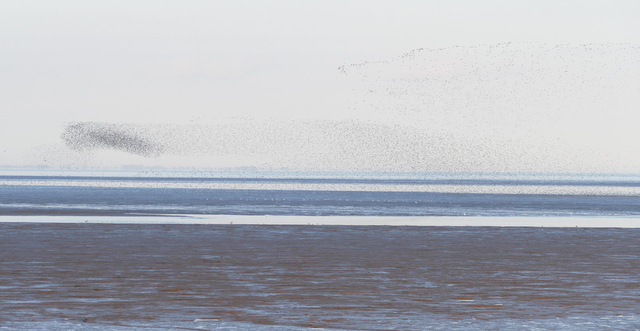
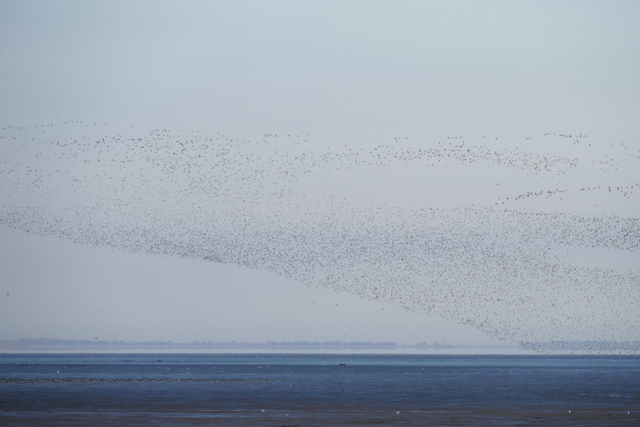
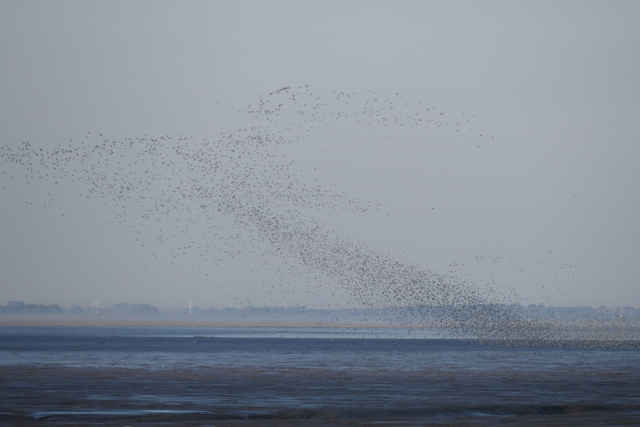 We were greeted to a great swirling flock as we arrived
We were greeted to a great swirling flock as we arrived
The Wash was looking stunning in the early morning light. We had arrived in good time, and there was still a lot of exposed mud. We knew that, as the tide rose, it would all disappear. It was a big tide today.
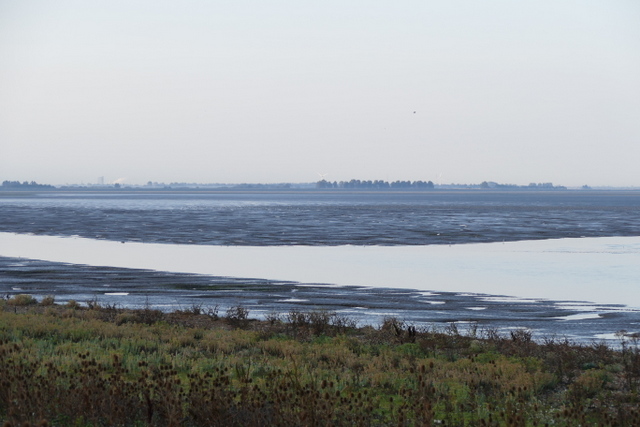 The Wash – looking towards King’s Lynn
The Wash – looking towards King’s Lynn
As the tide rose, we could see the waders gathering. There were lots of Oystercatcher, mostly standing rather sedately, looking distinctly unflustered by the rising tide. The Knot and Bar-tailed Godwits were more of a seething mass, we could see the flock flowing up across the mud as the water rose.
Closer in, a growing flock of Dunlin were still feeding feverishly on the edge of the rapidly filling channel. A single pale silvery-grey Sanderling dropped in with them, as did several Ringed Plover. A Greenshank appeared on one of the small pools on the mud and started to look for food.
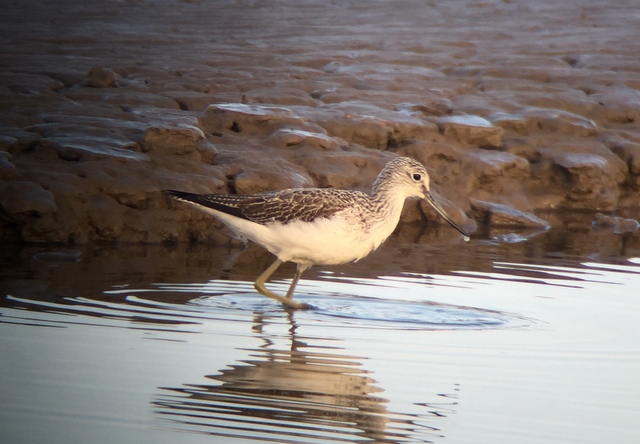 Greenshank – feeding on one of the pools by the seawall
Greenshank – feeding on one of the pools by the seawall
As the tide rose, the waders were progressively pushed into tighter flocks.
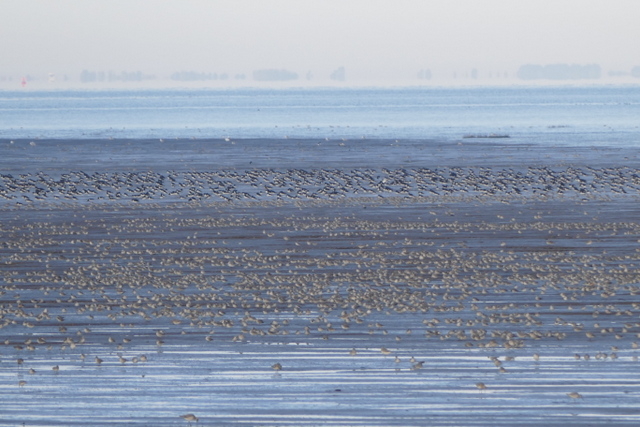 Waders – progressively pushed together by the rising tide
Waders – progressively pushed together by the rising tide
There was a single moulting Eider out on the mud amongst the waders. It looked slightly incongruous as it walked amongst them.
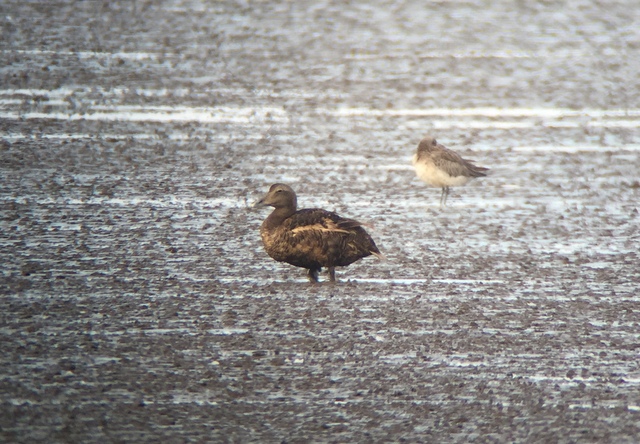 Eider – a single moulting bird was out on the mud with the waders
Eider – a single moulting bird was out on the mud with the waders
Gradually, as the waters rose, the waders started to peel off in small groups and head for the gravel its behind. The Oystercatchers seemed to go first, followed by little groups of Knot.
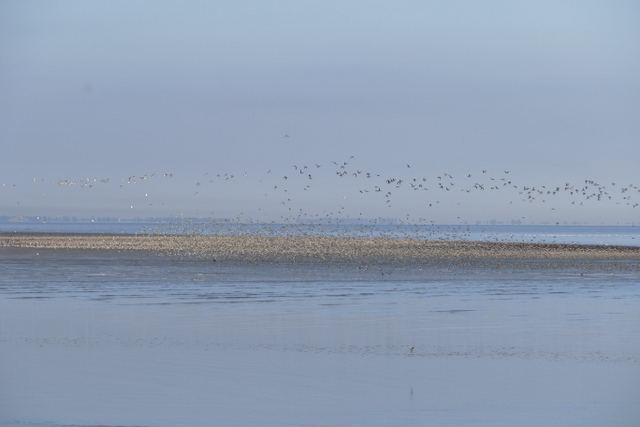 Waders – starting to fly off to the pits
Waders – starting to fly off to the pits
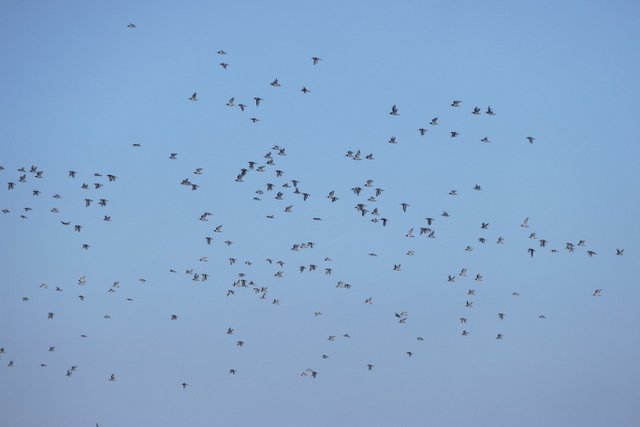 Oystercatchers – flying in from the Wash to roost
Oystercatchers – flying in from the Wash to roost
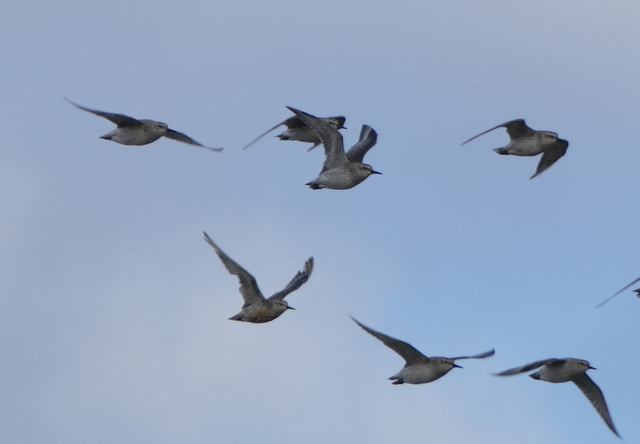 Knot – small groups peeling off from the mud at first
Knot – small groups peeling off from the mud at first
As the flock of waders became ever more concentrated on to a smaller and smaller area of mud, eventually the bigger flocks started to take off in spectacular numbers.
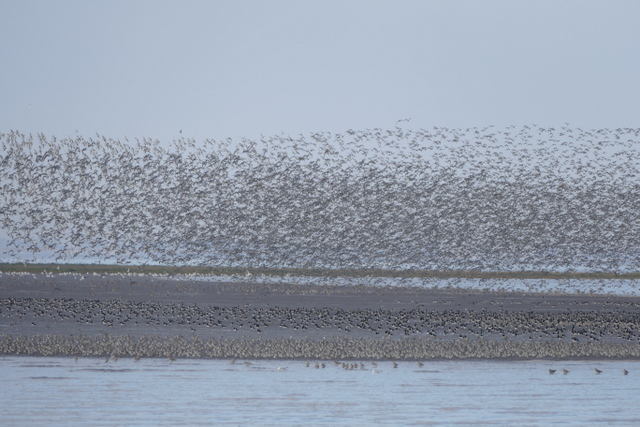 Waders – eventually the bulk of the flock took to the air
Waders – eventually the bulk of the flock took to the air
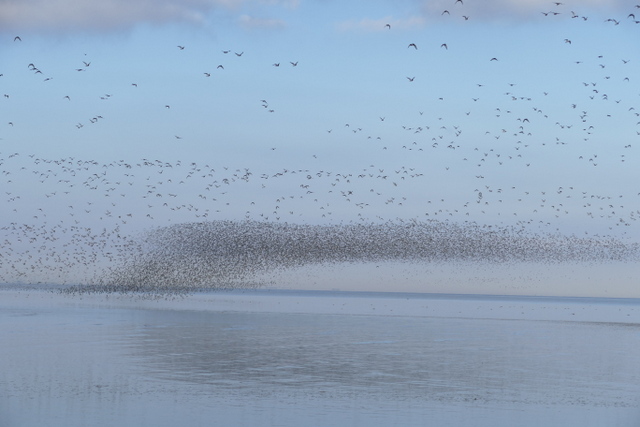
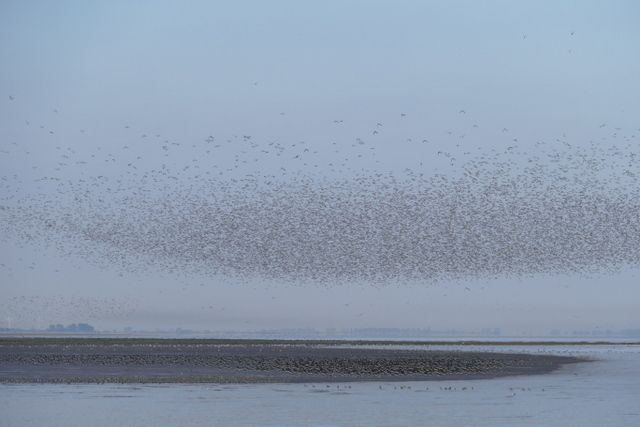
 They made some amazing shapes again as they swirled round
They made some amazing shapes again as they swirled round
There were an estimated 60,000 Knot present alone today. It was truly spectacular to see them as the bulk of them took to the air.

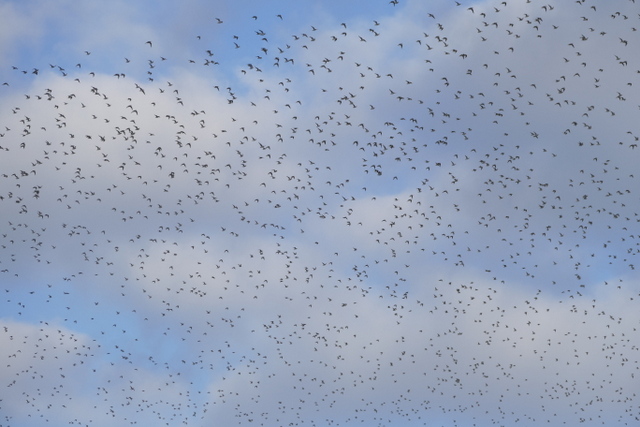
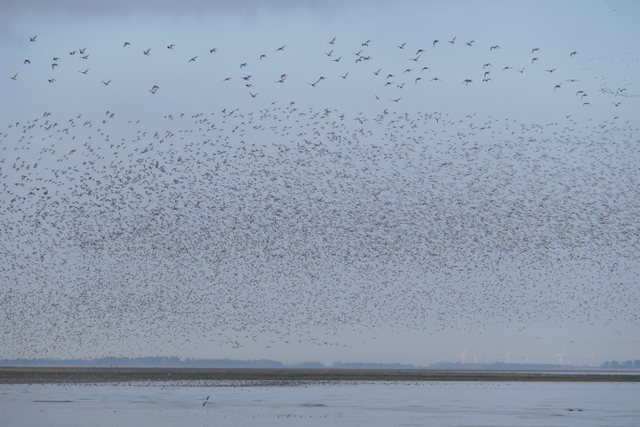
 Waders – vast numbers of Knot came off the Wash and overhead
Waders – vast numbers of Knot came off the Wash and overhead
After the bulk of the waders had left the mud, we headed for the hides. It was amazing to see the birds packed tightly onto the small islands, jostling for position. As more birds flew in and landed amongst them, the flock rearranged itself in a seething mass.
 Knot & Black-tailed Godwits – packed tightly onto the islands
Knot & Black-tailed Godwits – packed tightly onto the islands
With the birds roosting on the old gravel pits, we got a chance to look through and pick out a couple of different species. We had heard a Spotted Redshank calling earlier, as the waders were flying in to the pits. Out roosting in the middle, up to their bellies in the water, we found four of them. They were mostly asleep, but woke up just long enough for us to get a good look at their long, needle fine bills.
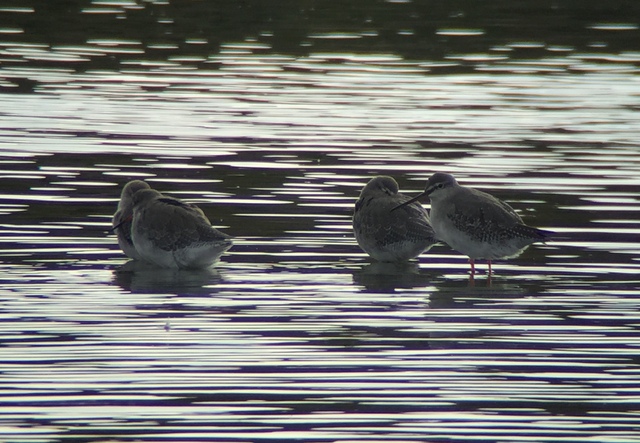 Spotted Redshank – four roosting on the gravel pits
Spotted Redshank – four roosting on the gravel pits
The islands close to the hide are mainly deserted – there is probably just too much noise and too many cameras. However, a Turnstone dropped down in front of us briefly, a moulting adult still sporting some rusty feathers in its upperparts left over from summer. A Grey Plover also flew into one of the tern islands giving us a great close-up view through the scope.
 Grey Plover – on one of the now deserted tern islands
Grey Plover – on one of the now deserted tern islands
There were other things to look at too, from the hide. Lots of ducks, particularly a growing number of Wigeon in for the winter. Most are still in eclipse plumage, but one or two drakes were starting to get greyer body feathers and the distinctive yellow flash up the forehead. Amongst them were several Teal and Shoveler, and a single moulting drake Pintail (though we had seen a few more out on the Wash earlier).
A Kingfisher flashed past right below the front of the hide. It disappeared quickly along the edge of the put but a couple of minutes later it was back again flying the other way.
The waders were slow to leave the pits today and head back to the Wash. We ventured out from the hide as the first groups of Oystercatcher and Knot peeled off, to find the mud already starting to reappear. A steady trickle of Oystercatcher came back over and a couple of lines of Knot, flying low out of the pits and over the bank. The Bar-tailed Godwits all appeared from over on the fields further north and dropped back down on the mud. A small party of Avocet were out feeding in the shallow water.
We could see a Peregrine sat on a fence post over the other side of the mud. It seemed to be eyeing the waders carefully, but they seemed either not to notice it or perhaps unperturbed as long as it was resting. We watched it for a while and then took our eyes off it.
 Peregrine – on a fence post beyond the waders, eyeing them up
Peregrine – on a fence post beyond the waders, eyeing them up
Suddenly, the waders on the mud erupted and started to swirl round again. With the sun now out, they looked stunning, really shining white as their underparts caught the morning light. As we looked at them, we could see the Peregrine powering through the middle of them. It didn’t seem to be interested in chasing after any of them – perhaps it was doing it just for fun?

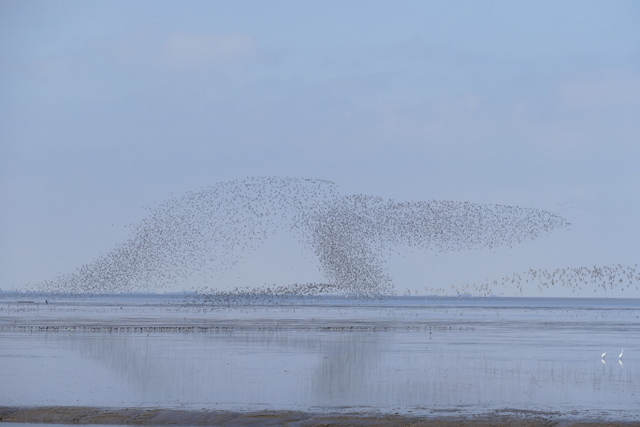 Knot – swirling around again as the Peregrine came over
Knot – swirling around again as the Peregrine came over
It had been a spectacular morning, but we finally tore ourselves away and made our way back along the coast. We made for Holkham and parked on Lady Anne’s Drive. Over lunch, we watched a pair of Red Kite circling over the grazing marshes and listened to the noise of the growing flock of several thousand Pink-footed Geese.
 Pink-footed Geese – the flocks are now growing fast as birds return
Pink-footed Geese – the flocks are now growing fast as birds return
After lunch, we walked west on the inland side of the pines. We encoutered several small flocks of tits, Long-tailed, Blue, Great and Coal Tits, together with Treecreepers and Goldcrests. Little groups of Siskin called overhead as they buzzed in and out of the pines. At Salts Hole, we stopped to admire the regular Little Grebes out on the water.
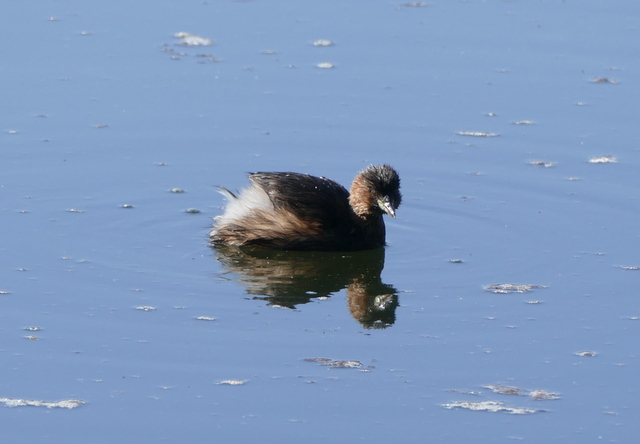 Little Grebe – one of at least 4 on Salts Hole today
Little Grebe – one of at least 4 on Salts Hole today
We had almost got to the crosstracks, when we bumped into a couple of birders who had just seen a Yellow-browed Warbler. We looked for it for a minute or so, but they didn’t know whether it had moved through with a tit flock or was still in the tree. We decided to walk on to see if we could connect with the tits again. A little further on, we spoke to someone else who had seen several Yellow-browed Warblers on the edge of the pines in that area. Walking up and down that stretch of the path, we heard a Yellow-browed Warbler call and finally managed to get on it, flitting around in the top of a small sycamore. It was hard to see at times amongst the leaves, but eventually popped out into the open, before flying over the path and into the pines.
Satisfied, we made our way back to the crosstracks and had a quick look for another Yellow-browed Warbler which had been seen there, near to where the first had been reported. We could hear Long-tailed Tits calling as we approached, so followed the sounds of the tits. We found a couple of Goldcrests feeding low down in the saplings. Then the Yellow-browed Warbler flew across the path and landed in the top of a holm oak. We could see its bright whitish supercilium and double wing bars. Then it flew up into the tops of the pines and disappeared.
There were lots of insects out in the warm sunshine – dragonflies including lots of Common Darters and a few Migrant Hawkers, plus several species of butterfly.
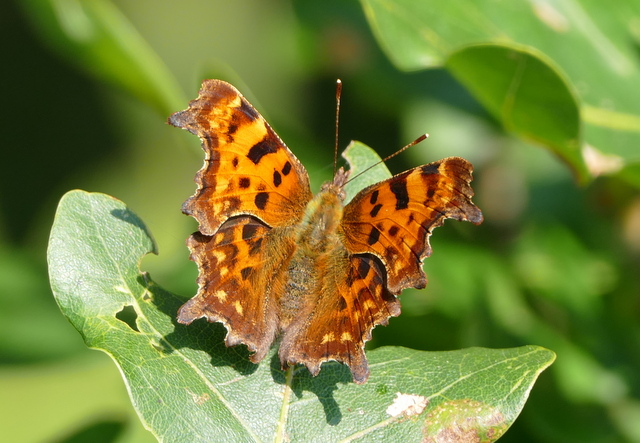 Comma – enjoying the sunshine this afternoon
Comma – enjoying the sunshine this afternoon
We had really hoped to get a better look at the Pink-footed Geese but there was no sign of them from Joe Jordan hide, on the fields where they had seemed to land earlier. We could see they had headed back towards Lady Anne’s Drive. We walked back to see if we could see them there, stopping briefly to admire three Marsh Harriers circling over the freshmarsh, two of them talon-grappling. A Redstart hopped up briefly in a tree in front of us before flying off across the path towards Salts Hole. The Pink-footed Geese had seemingly headed back towards the hides by the time we got back to the car, but it was already time to call it a day and head for home.
















